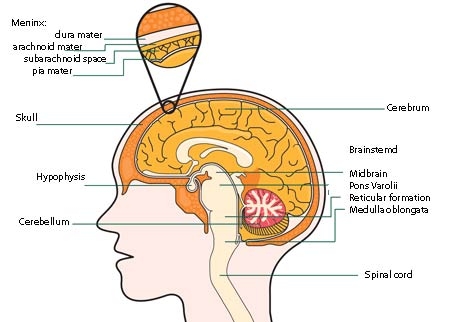Neurorehabilitation » Brain tumors. Recovery and rehabilitation. » Tumors of the Central Nervous System
Tumors of the Central Nervous System
The central nervous system (CNS) includes parts of the nervous system located inside the skull or the vertebral column. The nerves lying outside the skull and spine constitute the peripheral nervous system. The brain consists of the following parts: paired large hemispheres, intermediate brain, cerebellum and brainstem. Each region has its own functions.

The hemispheres of the brain are responsible for thinking, emotions, speech, muscle movements, vision, hearing, tactile and pain sensitivity. The diencephalon is responsible for motor and sensory activity, thermoregulation, water-salt balance, thirst and hunger, production of pituitary hormones. The cerebellum controls the movements of the body, balance and posture. The brainstem includes the medulla oblongata, the pons Varolii and the midbrain. The medulla oblongata includes important centers of reflex regulation of vegetative functions, including regulation of blood circulation, breathing, swallowing, salivation, sneezing, vomiting, coughing. The pons Varolii contains both ascending and descending neural pathways, as well as the nuclei switching the impulses to the cerebellum. The midbrain includes the centers of visual and auditory reflexes. The spinal cord is a conductor of four kinds of sensitivity: tactile, temperature, pain and proprioceptive.
This section includes information on brain and spinal cord tumors::
- Classification
- Causes of the tumors developing in the central nervous system
- Symptoms of CNS tumors
- Prognosis
Tumor growth is based on the cell’s damaged genetic material which leads to the disruption of its growth control. Type of genetic defect or its multiple presence defines the tumor type. Tumor process can start in any part of the brain or spinal cord.
Clinical manifestations of CNS (central nervous system) tumors depend on their location and size. Key warning signs of a brain tumor are: Morning headache or headache which subsides after vomiting. Frequent nausea and vomiting. Vision, hearing, speech disorders. Loss of balance and gait impairment. Weakness on one of the body parts. Unusual drowsiness (sleepiness) or changed level of every day physical activity. Bizarre personality or behavioral deviations.
The prognosis (chance of recovery) and treatment options for primary brain tumors depend on the following: Type and extent of the tumor. Possibility of surgical removal. Cancer cells after surgery (if available). Changes in the chromosomes (if available). Primary or recurrent cancer. Patient’s overall health.
The modern classification of tumors of the CNS uses a dual grading system for determining the degree of malignancy. The first encodes according to the ICD -O system, where the degree of malignancy is denoted by numbers in a fraction:



